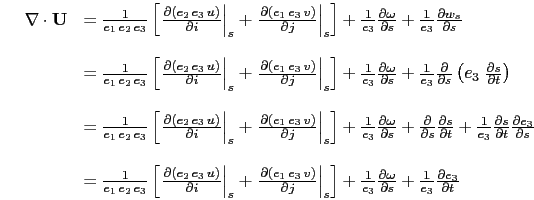Next: Momentum Equation in coordinate Up: Curvilinear Coordinate Equations Previous: The chain rule for Contents Index
Using (A.2) and the fact that the horizontal scale factors
![]() and
and ![]() do not depend on the vertical coordinate, the divergence of
the velocity relative to the (
do not depend on the vertical coordinate, the divergence of
the velocity relative to the (![]() ,
,![]() ,
,![]() ) coordinate system is transformed as follows
in order to obtain its expression in the curvilinear
) coordinate system is transformed as follows
in order to obtain its expression in the curvilinear ![]() coordinate system:
coordinate system:
![\begin{subequations}\begin{align*}{\begin{array}{*{20}l} \nabla \cdot {\rm {\bf ...
...u\;\sigma _1 - v\;\sigma _2 \right] \end{array} } \end{align*}\end{subequations}](img1414.png) |
Here, ![]() is the vertical velocity relative to the
is the vertical velocity relative to the ![]() coordinate system.
Introducing the dia-surface velocity component,
coordinate system.
Introducing the dia-surface velocity component, ![]() , defined as
the volume flux across the moving
, defined as
the volume flux across the moving ![]() -surfaces per unit horizontal area:
-surfaces per unit horizontal area:
 |
As a result, the continuity equation (2.1c) in the
![]() coordinates is:
coordinates is:
Gurvan Madec and the NEMO Team
NEMO European Consortium2017-02-17